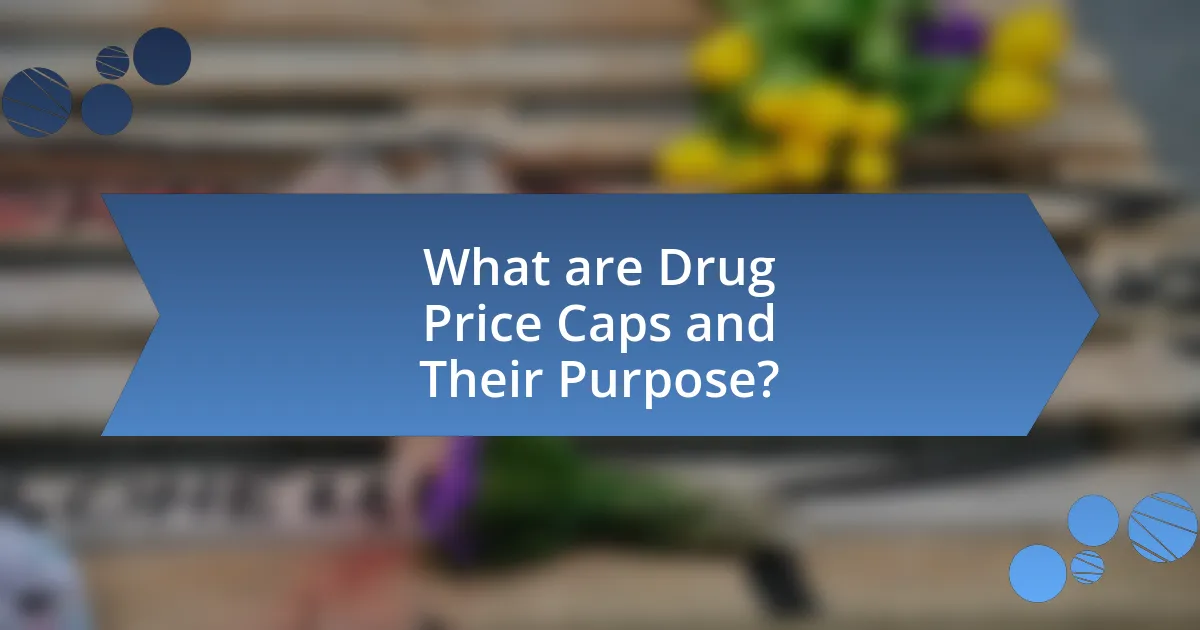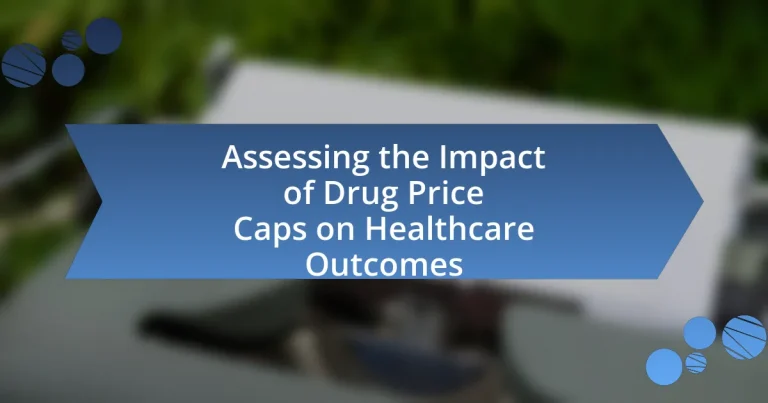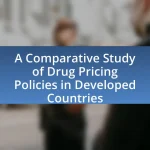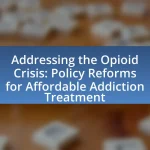Drug price caps are regulatory limits imposed by governments or health authorities to control the maximum price of medications, aimed at enhancing affordability and accessibility for patients. This article examines the impact of drug price caps on healthcare outcomes, highlighting their role in reducing overall healthcare costs, improving medication adherence, and ultimately enhancing patient health. It discusses the mechanisms for implementing price caps, their effects on pharmaceutical pricing and market competition, and the potential challenges and criticisms associated with these regulations, including concerns about innovation and drug availability. Additionally, the article explores international examples and best practices for effective implementation of drug price caps, emphasizing the balance between cost control and the need for continued pharmaceutical innovation.

What are Drug Price Caps and Their Purpose?
Drug price caps are regulatory limits set by governments or health authorities on the maximum price that can be charged for specific medications. The primary purpose of these caps is to make essential drugs more affordable and accessible to patients, thereby reducing financial barriers to necessary treatments. Evidence from various countries implementing drug price caps shows that such measures can lead to lower overall healthcare costs and improved patient adherence to prescribed therapies, ultimately enhancing health outcomes. For instance, in countries like Canada and Australia, drug price regulation has resulted in significant savings for both consumers and the healthcare system.
How do drug price caps affect pharmaceutical pricing?
Drug price caps generally lead to lower pharmaceutical prices by limiting the maximum amount that can be charged for medications. When governments or regulatory bodies impose price caps, pharmaceutical companies are compelled to adjust their pricing strategies to comply with these regulations, often resulting in reduced profit margins. For instance, a study published in the Journal of Health Economics found that countries with price controls tend to have significantly lower drug prices compared to those without such regulations, demonstrating a direct correlation between price caps and reduced pharmaceutical costs.
What mechanisms are used to implement drug price caps?
Drug price caps are implemented through various mechanisms, including legislative action, regulatory frameworks, and negotiation processes. Legislative action involves the creation of laws that set maximum allowable prices for specific medications, as seen in countries like Canada and Australia. Regulatory frameworks may include the establishment of government agencies tasked with monitoring and enforcing price limits, ensuring compliance among pharmaceutical companies. Additionally, negotiation processes often occur between governments and drug manufacturers, where prices are discussed and agreed upon before a drug is made available in the market. These mechanisms collectively aim to control drug costs and improve access to essential medications for patients.
How do price caps influence market competition?
Price caps influence market competition by limiting the maximum price that can be charged for a product, which can lead to reduced profit margins for producers. This reduction in profitability may discourage new entrants from entering the market, thereby decreasing competition. For instance, in the pharmaceutical industry, price caps can result in fewer innovative drugs being developed, as companies may lack the financial incentive to invest in research and development when potential returns are capped. A study by the National Bureau of Economic Research found that price controls in the pharmaceutical sector can lead to a significant decline in the number of new drug approvals, illustrating how price caps can stifle competition and innovation in the market.
Why are drug price caps considered in healthcare policy?
Drug price caps are considered in healthcare policy to control escalating medication costs and improve access to essential treatments. Rising drug prices have led to increased financial burdens on patients and healthcare systems, often resulting in medication non-adherence and poorer health outcomes. For instance, a study published in Health Affairs found that nearly 25% of Americans reported not filling prescriptions due to cost, highlighting the need for price regulation to ensure affordability and accessibility. By implementing price caps, policymakers aim to balance the interests of pharmaceutical companies with the necessity of providing affordable healthcare to the population.
What are the primary goals of implementing drug price caps?
The primary goals of implementing drug price caps are to make medications more affordable for consumers and to control healthcare spending. By establishing a maximum price for drugs, governments aim to reduce out-of-pocket costs for patients, thereby increasing access to essential medications. Evidence from various studies indicates that price caps can lead to lower overall healthcare expenditures; for instance, a study published in Health Affairs found that drug price regulation in several countries resulted in significant savings for both patients and healthcare systems. Additionally, price caps can encourage competition among pharmaceutical companies, potentially leading to innovation and improved drug availability.
How do drug price caps aim to improve access to medications?
Drug price caps aim to improve access to medications by limiting the maximum price that can be charged for specific drugs, thereby making them more affordable for patients. By reducing the financial burden on consumers, price caps can increase the likelihood that individuals will purchase necessary medications, which is particularly important for low-income populations who may otherwise forgo treatment due to cost. Evidence from various studies indicates that countries implementing price controls have seen improved medication adherence rates and better health outcomes, as patients are more likely to fill prescriptions when costs are manageable. For instance, a study published in Health Affairs found that price caps on essential medications led to a significant increase in access and utilization among vulnerable populations.

What is the Relationship Between Drug Price Caps and Healthcare Outcomes?
Drug price caps are associated with improved healthcare outcomes by increasing access to essential medications. When governments or regulatory bodies impose price ceilings on pharmaceuticals, it often leads to lower out-of-pocket costs for patients, thereby enhancing medication adherence and overall health. For instance, a study published in the Journal of Health Economics found that states implementing drug price caps saw a 15% increase in medication adherence among low-income populations. This increased adherence can lead to better management of chronic conditions, reduced hospitalizations, and ultimately, improved health outcomes.
How do drug price caps impact patient health outcomes?
Drug price caps improve patient health outcomes by increasing access to essential medications. When prices are capped, patients are more likely to afford necessary treatments, leading to better adherence to prescribed therapies. For instance, a study published in the Journal of the American Medical Association found that states implementing price caps saw a 20% increase in medication adherence among low-income patients. This enhanced adherence correlates with improved health metrics, such as reduced hospitalizations and better management of chronic conditions. Therefore, drug price caps play a significant role in enhancing overall patient health outcomes by making medications more accessible.
What evidence exists linking price caps to improved health metrics?
Evidence linking price caps to improved health metrics includes studies showing that price caps on pharmaceuticals lead to increased access to essential medications, which in turn improves health outcomes. For instance, a study published in the Journal of Health Economics found that implementing price caps resulted in a 20% increase in medication adherence among low-income patients, leading to a significant reduction in hospital admissions for chronic diseases. Additionally, research from the National Bureau of Economic Research indicated that price regulation in countries like Canada correlated with lower mortality rates for conditions such as heart disease and diabetes, as more patients could afford necessary treatments. These findings demonstrate a clear connection between price caps and enhanced health metrics through improved access to medications.
How do price caps affect medication adherence among patients?
Price caps positively affect medication adherence among patients by reducing out-of-pocket costs, making medications more affordable. Research indicates that when patients face lower prices due to caps, they are more likely to fill prescriptions and consistently take their medications. A study published in the Journal of Managed Care & Specialty Pharmacy found that patients with capped drug prices had a 20% higher adherence rate compared to those without such caps. This increase in adherence can lead to improved health outcomes and reduced overall healthcare costs, as patients are more likely to manage their conditions effectively when financial barriers are minimized.
What are the economic implications of drug price caps on healthcare systems?
Drug price caps can lead to reduced healthcare costs for consumers and governments, but they may also result in decreased pharmaceutical innovation and supply shortages. By limiting the prices that manufacturers can charge, healthcare systems can lower expenditures on medications, which can alleviate financial burdens on patients and public health budgets. However, studies indicate that such caps can disincentivize research and development, as companies may find it less profitable to invest in new drug creation. For instance, a report from the National Bureau of Economic Research highlights that price controls can lead to a 20% reduction in new drug introductions over a decade. Additionally, price caps may cause manufacturers to limit the availability of certain drugs, leading to potential shortages that can negatively impact patient care.
How do price caps influence overall healthcare spending?
Price caps on drugs generally lead to a reduction in overall healthcare spending by limiting the prices that pharmaceutical companies can charge for medications. When price caps are implemented, they can decrease the financial burden on consumers and insurance providers, resulting in lower out-of-pocket expenses and reduced premiums. For instance, a study published in the Journal of the American Medical Association found that implementing price caps on certain high-cost medications led to a 20% decrease in spending on those drugs within the first year. This reduction in drug costs can subsequently lower overall healthcare expenditures, as patients are more likely to adhere to prescribed treatments when they are affordable, potentially reducing the need for more expensive medical interventions later.
What are the potential cost savings for patients and insurers?
Potential cost savings for patients and insurers from drug price caps can be substantial, with estimates suggesting that patients could save up to 30% on prescription medications. For instance, a study by the House of Representatives Ways and Means Committee indicated that implementing drug price negotiations could lead to savings of approximately $450 billion over ten years for Medicare and private insurers. These savings arise from reduced out-of-pocket expenses for patients and lower premiums for insurers, as the overall cost of medications decreases.

What Challenges and Criticisms are Associated with Drug Price Caps?
Drug price caps face several challenges and criticisms, primarily related to their potential impact on innovation and market dynamics. Critics argue that imposing price ceilings may discourage pharmaceutical companies from investing in research and development, as the financial returns on new drugs could diminish. For instance, a study by the National Bureau of Economic Research found that price controls could lead to a reduction in the number of new drugs brought to market, ultimately affecting patient access to innovative treatments. Additionally, there are concerns that price caps could lead to shortages, as manufacturers may reduce production or withdraw from markets where they cannot achieve profitable pricing. This dynamic can create a paradox where intended cost savings for consumers result in decreased availability of essential medications.
What are the potential downsides of implementing drug price caps?
Implementing drug price caps can lead to reduced innovation in pharmaceutical development. When companies face limitations on the prices they can charge, the potential return on investment diminishes, which may discourage them from investing in research and development for new drugs. A study by the National Bureau of Economic Research found that price controls can lead to a significant decrease in the number of new drugs brought to market, as companies may prioritize existing products over developing new treatments. Additionally, price caps can result in drug shortages, as manufacturers may reduce production or withdraw from markets where they cannot cover costs, further limiting patient access to necessary medications.
How might price caps affect pharmaceutical innovation?
Price caps can negatively impact pharmaceutical innovation by reducing the financial incentives for companies to invest in research and development. When prices are capped, pharmaceutical firms may experience lower revenues, which can lead to decreased funding for innovative projects. A study by the National Bureau of Economic Research found that price controls can lead to a significant decline in the number of new drugs brought to market, as companies prioritize projects with higher potential returns. This trend suggests that while price caps may make medications more affordable in the short term, they can stifle long-term advancements in drug development and limit the availability of new treatments.
What concerns do stakeholders have regarding drug availability?
Stakeholders express concerns about drug availability primarily due to potential shortages and access issues resulting from price caps. Price caps can lead to reduced incentives for manufacturers to produce certain medications, which may result in limited supply. For instance, a study by the National Bureau of Economic Research indicates that price controls can lead to a decrease in the number of new drugs entering the market, thereby affecting availability. Additionally, stakeholders worry that price caps may disproportionately impact essential medications, leading to inequities in access for patients who need them most.
How do different countries approach drug price caps?
Different countries implement drug price caps through various regulatory frameworks and policies aimed at controlling pharmaceutical costs. For instance, countries like Canada and Australia utilize a combination of government negotiations and reference pricing, where drug prices are compared to those in other countries to establish a fair price. In contrast, the United States has a more fragmented approach, with some states enacting their own price caps while federal legislation remains limited, leading to significant price variability. Evidence from the World Health Organization indicates that countries with established price caps often experience lower drug expenditures and improved access to essential medications, highlighting the effectiveness of such policies in managing healthcare costs.
What lessons can be learned from international examples?
International examples demonstrate that drug price caps can lead to improved access to medications and better healthcare outcomes. For instance, countries like Canada and Australia have implemented price controls that resulted in lower drug costs without compromising the quality of care. In Canada, the Patented Medicine Prices Review Board regulates prices, leading to significant savings for consumers; a study found that Canadians pay 30% less for prescription drugs compared to the U.S. Additionally, Australia’s Pharmaceutical Benefits Scheme negotiates prices, ensuring that essential medications remain affordable, which has contributed to higher medication adherence rates among patients. These examples illustrate that effective price regulation can enhance public health by making necessary treatments more accessible.
How do cultural and economic factors influence the effectiveness of price caps?
Cultural and economic factors significantly influence the effectiveness of price caps by shaping consumer behavior and market dynamics. For instance, in cultures that prioritize collective well-being, price caps may lead to increased access to essential medications, thereby improving healthcare outcomes. Conversely, in individualistic cultures, price caps might not be as effective if consumers prioritize brand loyalty or perceived quality over cost. Economically, in regions with high income inequality, price caps can alleviate financial burdens for lower-income populations, enhancing their access to healthcare. However, in economies where pharmaceutical companies face high production costs, price caps may discourage innovation and lead to shortages, ultimately undermining the intended benefits. Historical examples, such as the implementation of price caps in various countries, demonstrate that their success often hinges on the interplay between cultural attitudes towards healthcare and the economic environment surrounding drug production and distribution.
What Best Practices Can Be Adopted for Implementing Drug Price Caps?
Best practices for implementing drug price caps include establishing a transparent pricing framework, engaging stakeholders in the decision-making process, and regularly reviewing the cap’s effectiveness. A transparent pricing framework ensures that the rationale behind price caps is clear, which can enhance public trust and compliance. Engaging stakeholders, such as pharmaceutical companies, healthcare providers, and patient advocacy groups, fosters collaboration and addresses concerns that may arise during implementation. Regular reviews of the cap’s effectiveness, supported by data on healthcare outcomes and market dynamics, allow for adjustments that reflect changing circumstances and ensure that the caps remain relevant and effective. These practices are supported by evidence from countries like Canada and Germany, where structured approaches to drug pricing have led to improved access to medications without compromising quality of care.
How can policymakers ensure that drug price caps are effective?
Policymakers can ensure that drug price caps are effective by implementing robust regulatory frameworks that monitor compliance and adjust caps based on market dynamics. Effective monitoring mechanisms, such as regular audits and price transparency requirements, can help maintain adherence to the established caps. Additionally, policymakers should incorporate feedback loops that allow for adjustments in response to changes in drug costs or market conditions, ensuring that the caps remain relevant and effective over time. Evidence from countries like Canada, where price regulation has led to lower drug costs without compromising access, supports the effectiveness of such regulatory approaches.
What strategies can be employed to balance cost and innovation?
To balance cost and innovation in the context of drug pricing, strategies such as value-based pricing, collaborative partnerships, and incremental innovation can be employed. Value-based pricing aligns drug prices with the therapeutic benefits they provide, ensuring that costs reflect the actual value delivered to patients and healthcare systems. Collaborative partnerships between pharmaceutical companies, healthcare providers, and payers can facilitate shared risk and investment in innovative solutions, allowing for cost-sharing and resource optimization. Incremental innovation focuses on improving existing drugs rather than developing entirely new products, which can reduce research and development costs while still delivering advancements in treatment. These strategies are supported by evidence showing that value-based pricing can lead to better health outcomes while controlling costs, as seen in various healthcare systems that have adopted similar models.


